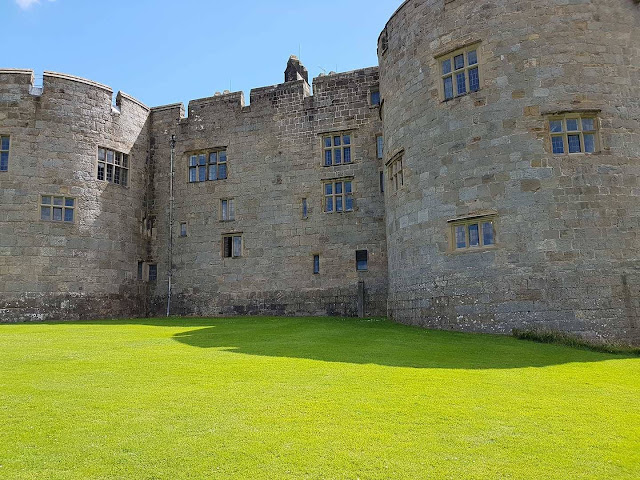Chirk (Welsh: Y Waun, meaning The Moor) is a small town and local government community in Wales. It is located in the traditional county of Denbighshire, although is currently administered as part of Wrexham County Borough. In the 2011 census, it had a population of 4,468. It is located 10 miles south of Wrexham.
It is situated between Wrexham and Oswestry and has been part of the County Borough since local government reorganisation in 1996. The border with the English county of Shropshire is immediately south of the town, on the other side of the River Ceiriog.
The town is served by Chirk railway station and the A5/A483 roads.
 |
Chirk Castle Wales The UK |
 | |||||||
The castle was built in 1295 by Roger Mortimer de Chirk, uncle of Roger Mortimer, 1st Earl of March as part of King Edward I's chain of fortresses across the north of Wales. It guards the entrance to the Ceiriog Valley. It was the administrative centre for the Marcher Lordship of Chirkland.
The castle was bought by Sir Thomas Myddelton in 1593 for £5,000 (approx. £11 million as of 2008). His son, Thomas Myddelton of Chirk Castle was a Parliamentarian during the English Civil War, but became a Royalist during the 'Cheshire rising' of 1659 led by George Booth, 1st Baron Delamer. Following the Restoration, his son became Sir Thomas Myddelton, 1st Baronet of Chirke. The castle passed down in the Myddelton family to Charlotte Myddelton (on the death of her father in 1796). Charlotte had married Robert Biddulph, who changed his name to Robert Myddelton-Biddulph, leaving the castle on his death to their son Robert. It then passed down in the Myddelton-Biddulph family.
During the 1930s the Castle was home to Thomas Scott-Ellis, 8th Baron Howard de Walden, a prominent patron of the arts and champion of Welsh culture. The Myddelton family resided at Chirk Castle until 2004. Lieutenant-Colonel Ririd Myddleton was an extra equerry to Queen Elizabeth II from 1952 until his death in 1988.
The castle is owned by National Trust and is open to the public between March and October, with limited opening dates in November and December. Access is by road; the castle itself is located 1.5 mi (2.4 km) from the Chirk railway station. The property is also notable for its gardens, with clipped yew hedges, herbaceous borders, rock gardens and terraces and surrounded by 18th century parkland.
Chirk Castle, a National Trust property, is a medieval castle. Two families are associated with the town and its castle, the Trevor family of Brynkinallt and the Myddelton families. The Hughes of Gwerclas, a family descended from the ancient kings of Powys, also dwelt in the area for many years.
Attractions in the town apart from Chirk Castle include a section of Offa's Dyke and the Chirk Aqueduct, part of a larger World Heritage Site including Pontcysyllte aqueduct, on the Llangollen Canal, built in 1801 by Thomas Telford. The Glyn Valley Tramway operated from here.
The Parish Church of St Mary's is a Grade I listed building. The current church building was begun during the 11th Century by the Normans, although it is believed that an older llan, dedicated to St Tysilio, had existed on the site. Indeed, the current church was known by the dedication of St Tysilio until the late 15th or early 16th century, after which it was re-dedicated to St Mary. Today, the church is a member of the Open Church Network and participates in the Sacred Space Project.
Chirk was formerly a coal mining community with coal being worked since the 17th century. The largest of these collieries were Black Park (one of the oldest in the north of Wales) and Brynkinallt (Welsh: Bryncunallt). These coal mines have now closed.
Chirk was a coaching stop on the old Mail coach route along the A5 from London to Holyhead.
Chirk Aqueduct is a 70-foot (21 m) high and 710-foot (220 m) long navigable aqueduct that carries what is now the Llangollen Canal across the Ceiriog Valley near Chirk, on the England-Wales border, spanning the two countries.
The aqueduct was designed by Thomas Telford for the Ellesmere Canal. The foundation stone was laid on 17 June 1796 and it was completed in 1801. It has a cast iron trough within which the water is contained. The masonry walls hide the cast iron interior. The aqueduct followed Telford's innovative Longdon-on-Tern Aqueduct on the Shrewsbury Canal, and was a forerunner of the Pontcysyllte Aqueduct, also on the Llangollen Canal. The aqueduct was briefly the tallest navigable one ever built, and it now is Grade II* listed in both England and Wales. It forms part of the Pontcysyllte Aqueduct World Heritage Site.
Looking towards Wales along the Aqueduct. The entrance to the Chirk Tunnel is visible behind it.
The aqueduct consists of ten arches, each with a span of 40 feet (12 m). The water level is 65 feet (20 m) above the ground and 70 feet (21 m) above the River Ceiriog. The stone work is yellow sandstone. William Hazledine provided the ironwork for the aqueduct. Originally built with iron plates only at the base of the trough, iron side plates were added to the aqueduct in 1870 to alleviate leakage.
The Chirk Tunnel starts at the north end of the Chirk Aqueduct, allowing the canal to continue on towards Llangollen. A railway viaduct was built later alongside the aqueduct. It is higher than the aqueduct, which was specifically included in the design in order to emphasise the superiority of rail transportation over water modes.
Thai fish cake
cod and prawn





























































No comments:
Post a Comment